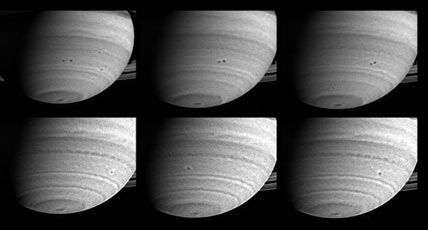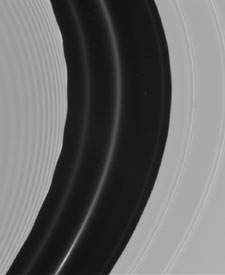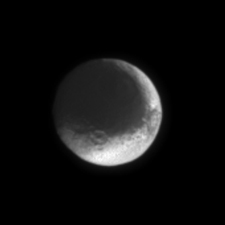
Between February and March 2004, months before its arrival at Saturn, the Cassini spacecraft observed two merging storms. The spots (dark dots), found in 'storm alley' in the southern hemisphere, were each nearly 1,000 kilometers across before they joined.
Courtesy NASA/JPL/Space Science Institute.
Hundreds of scientists around the world continue to pore over images and data from the Cassini spacecraft following its successful July 1st insertion into Saturn orbit and its October 26th close flyby of the cloud-enshrouded moon Titan. The latest results, presented on November 8th at the American Astronomical Society's Division of Planetary Sciences meeting in Louisville, Kentucky, include a mysterious circular feature on Titan and mountains on Iapetus that might be the highest in the solar system. "It's an embarrassment of riches," says Carolyn Porco (Space Science Institute), principal investigator of Cassini's camera system.
Some of the highlights include:
A belt in Saturn's upper atmosphere at 36° south latitude has spawned several major storm systems in the past few months, leading to the moniker "storm alley."
Scientists have confirmed that major storm systems in Saturn's atmosphere spark powerful electrostatic discharges — in other words, lightning. Experts have puzzled over the origin of the lightning since the Voyager flybys of the early 1980s.
A huge cloud of hydrogen atoms extends 45 Saturnian radii from the planet's equator. A rapidly variable cloud of oxygen huddles closer in. The atoms come from ice particles knocked off the rings and moons by the incessant pounding of micrometeorites and collisions between moonlets in the rings. It seems that Saturn's radiation belts break the water molecules apart into their constituent hydrogen and oxygen atoms.
A major brightening of auroral activity in Saturn's polar region was recorded on July 25th, just as a solar wind shock front blew past the ringed planet.
Cassini has spotted two new tenuous rings so far. The first shares the same orbit as the small moon Atlas, which lies in the narrow region between the A and F rings. The second discovery was also located in the same region between A and F, just inside the orbit of Prometheus.

The moon Pan, not seen in this image, causes the scalloped-shaped waves on the inner edge of the Encke Division (dark section). By analyzing the pattern, scientists were able to deduce the mass of the diminutive moon.
Courtesy NASA/JPL/Space Science Institute.

Three newly found impact sites have given astronomers new ideas about the two-toned nature of Saturn's moon Iapetus. But perhaps more intriguing than its black and white nature are large mountains that may rival Mars's Olympus Mons as the highest peaks in the solar system. Cassini captured this image on July 3, 2004, from a distance of 3 million kilometers. In this image Iapetus is nearly full.
Courtesy NASA/JPL/Space Science Institute .
Scientists are still digging through gigabytes of data taken by Cassini's suite of a dozen instruments, and the spacecraft has four more years and 76 orbits to go before the end of the primary mission. Despite the "embarrassment of riches," the mission is just getting started. Cassini will fly within 2,400 kilometers of Titan on December 13th, and the European Space Agency's Huygens probe will parachute through Titan's atmosphere on January 14, 2005.



 0
0









Comments
You must be logged in to post a comment.